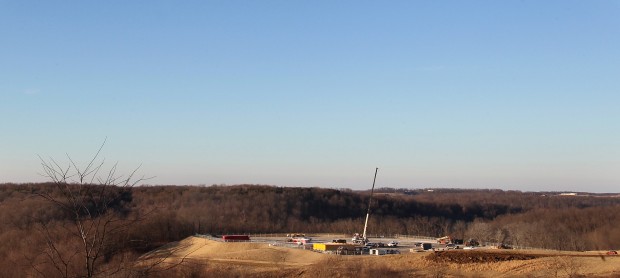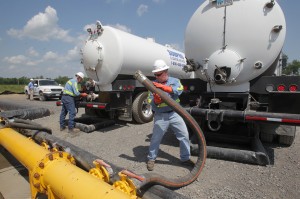
John Kuntz / The Plain Dealer
A Chesapeake Energy natural gas drilling site near Steubenville, Ohio.
This story comes from the non-profit investigative newsroom ProPublica, co-published with The Daily Beast:
At the end of 2011, Chesapeake Energy, one of the nation’s biggest oil and gas companies, was teetering on the brink of failure.
Its legendary chief executive officer, Aubrey McClendon, was being pilloried for questionable deals, its stock price was getting hammered and the company needed to raise billions of dollars quickly.
The money could be borrowed, but only on onerous terms. Chesapeake, which had burned money on a lavish steel-and-glass office complex in Oklahoma City even while the selling price for its gas plummeted, already had too much debt.
In the months that followed, Chesapeake executed an adroit escape, raising nearly $5 billion with a previously undisclosed twist: By gouging many rural landowners out of royalty payments they were supposed to receive in exchange for allowing the company to drill for natural gas on their property.
In lawsuits in state after state, private landowners have won cases accusing the companies like Chesapeake of stiffing them on royalties they were due. Federal investigators have repeatedly identified underpayments of royalties for drilling on federal lands, including a case in which Chesapeake was fined $765,000 for “knowing or willful submission of inaccurate information” last year. Continue Reading →

Mike Cardew/Akron Beacon Journal/MCT
Tom Bragg, left, of Sunpro Inc., works on finishing filling his truck with water as Gary Wortman takes off the filler hose from his truck after filling up with water at a Chesapeake Energy Corporation fresh water collection station at a sand and gravel pit, May 31, 2012, in Carroll County, Ohio.
From ProPublica:
When the Environmental Protection Agency abruptly retreated on its multimillion-dollar investigation into water contamination in a central Wyoming natural gas field last month, it shocked environmentalists and energy industry supporters alike.
In 2011, the agency had issued a blockbuster draft report saying that the controversial practice of fracking was to blame for the pollution of an aquifer deep below the town of Pavillion, Wy. – the first time such a claim had been based on a scientific analysis.
The study drew heated criticism over its methodology and awaited a peer review that promised to settle the dispute. Now the EPA will instead hand the study over to the state of Wyoming, whose research will be funded by EnCana, the very drilling company whose wells may have caused the contamination.
Industry advocates say the EPA’s turnabout reflects an overdue recognition that it had over-reached on fracking and that its science was critically flawed.
But environmentalists see an agency that is systematically disengaging from any research that could be perceived as questioning the safety of fracking or oil drilling, even as President Obama lays out a plan to combat climate change that rests heavily on the use of natural gas. Continue Reading →

